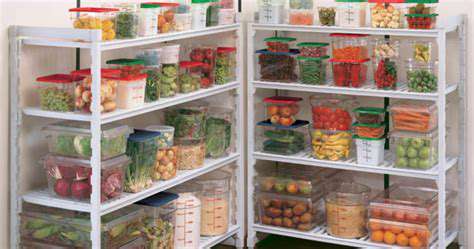How to Store Berries: Keep Them Fresh Longer
Jun 23, 2025 / btwgardenmachine/
Keeping berries at the right temperature is essential for maintaining their quality. Refrigeration slows down the ripening process and helps prevent spoilage. Make sure your refrigerator maintains a consistent temperature, as fluctuations can cause berries to degrade faster.
Freezing is another excellent option for extending the shelf life of berries. Freezing them soon after picking or buying helps preserve their texture and nutrients. Different berries may require specific freezing techniques, so it's worth researching the best method for each variety.
Humidity Management for Optimal Freshness
Controlling humidity is crucial, especially for delicate berries like strawberries. Too much moisture can lead to mold and a mushy texture. Using airtight containers or specialized produce bags that regulate humidity can make a big difference.
Managing humidity effectively during storage will help keep your berries fresh longer. This involves selecting the right containers and understanding how different storage environments affect moisture levels.
Storage Containers: Choosing the Right Vessels
The type of container you use can greatly impact how long your berries stay fresh. Airtight containers are best for preventing moisture loss or gain, which can cause spoilage. Opting for reusable containers is also an eco-friendly choice. Choose a container size that matches the amount of berries you're storing to ensure optimal conditions.
Pre-Storage Preparation: Ensuring a Fresh Start
Proper preparation before storage can significantly extend the life of your berries. Washing them thoroughly removes dirt and contaminants that could lead to spoilage. However, be gentle to avoid bruising, which can speed up deterioration.
Drying berries after washing is another key step. This reduces the risk of mold and mildew, helping your berries stay fresh longer when stored correctly.
Freezing Berries for Extended Storage
Freezing berries is a great way to preserve their flavor and nutrients for months. Quick freezing, ideally with a blast freezer, locks in their goodness and prevents freezer burn. Blanching or freezing them right after purchase or picking is often recommended.
Freezing berries in portion-sized amounts makes them easier to use later and reduces waste. Don't forget to label and date your frozen berries to keep track of their freshness.
Proper Handling and Preparation for Storage

Proper Food Handling: Crucial for Safety
Food safety is paramount, especially with raw ingredients. Proper handling prevents harmful bacteria and viruses from growing, reducing the risk of foodborne illnesses. Always wash your hands with soap and water before and after handling food, particularly raw meat, poultry, and seafood. This simple step eliminates potential contaminants. Using separate cutting boards and utensils for raw and cooked foods is also essential to avoid cross-contamination.
Preventing cross-contamination is key to stopping the spread of bacteria. Raw meat juices can transfer bacteria to other foods if not handled carefully. Separate cutting boards are a must. Storing perishable foods at the right temperatures is equally important. Refrigerate them promptly to slow bacterial growth and maintain quality.
Temperature Control: A Key Factor in Food Safety
Maintaining proper temperatures during food preparation is critical for preventing bacterial growth. Cold temperatures slow microorganism growth, while heat kills them. Refrigerate perishable foods within an hour of purchase or preparation. Use a food thermometer to ensure cooked foods reach a safe internal temperature, especially for meats, poultry, and eggs.
Cooking foods to the right temperature is vital for eliminating pathogens. Knowing the safe temperatures for different foods is crucial. A food thermometer is the best tool for this. It helps prevent food poisoning and ensures a safe meal. Proper reheating is also important to kill any bacteria that may have developed during storage.
Preparation Techniques to Minimize Risk
Good preparation techniques help prevent foodborne illness. Wash fruits and vegetables thoroughly before eating to remove dirt and bacteria. Sanitize cutting boards and utensils after each use, especially after handling raw meat. Store leftovers in airtight containers and refrigerate them quickly to prevent bacterial growth.
Using separate cutting boards for raw and cooked foods is a simple way to prevent cross-contamination. Handle raw meat, poultry, and seafood with care to avoid spreading harmful bacteria. Store these items properly to prevent contamination.
Importance of Hygiene and Cleanliness
A clean kitchen is essential for food safety. Regularly clean countertops, utensils, and cutting boards to prevent bacteria buildup. Use clean cloths and sponges, and sanitize all surfaces properly. Keeping the kitchen environment clean minimizes the risk of contamination.
Washing hands with soap and water before and after handling food is a basic but critical step. Good hygiene practices are vital for preventing bacterial spread. Regular cleaning and disinfecting of the kitchen area help reduce the risk of foodborne illness.

Freezing Berries for Long-Term Preservation
Freezing Berries for Optimal Quality
Freezing berries is an excellent way to preserve their freshness and flavor for months. The secret lies in proper preparation. Washing, drying, and sorting berries before freezing helps maintain their texture and taste. This initial step is crucial for successful long-term storage.
Freezing berries at their peak ripeness ensures the best flavor and nutritional value. The process halts enzymatic activity, preserving the fruit's natural qualities. This method is especially useful for maintaining the vibrant color and delicate structure of berries, allowing you to enjoy them long after harvest.
Preparing Berries for Freezing
Wash berries under cold running water to remove dirt and debris. Handle them gently to avoid bruising, which can affect their quality when thawed. Pat them dry to prevent excess moisture, which can cause freezer burn and clumping.
Sort berries by size and quality, discarding any damaged ones. This ensures only the best berries are frozen for future use. Attention to detail during preparation is key to successful freezing.
Freezing Methods for Optimal Results
Freeze berries in a single layer on a baking sheet before transferring them to freezer bags or containers. This prevents them from sticking together and helps maintain their shape. Once frozen solid, transfer them to airtight containers, removing as much air as possible to minimize freezer burn. Label the containers with the freezing date for easy tracking.
Packaging and Storage for Long-Term Preservation
Use freezer-safe bags or containers to keep berries fresh and prevent freezer burn. Freezing in individual portions makes it easy to use only what you need. Freezing berries in a single layer first helps maximize space and maintain their quality.
Thawing and Using Frozen Berries
Thaw frozen berries in the refrigerator to preserve their texture. For quicker thawing, place them in a colander to drain excess moisture. Frozen berries are versatile and can be used in smoothies, jams, pies, and sauces, adding a refreshing touch to various dishes.